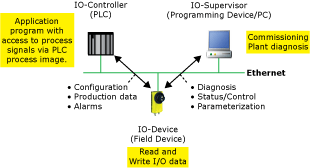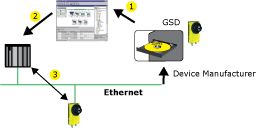PROFINET Communications
-
The In-Sight Explorer software contains below GSD files. Please use the appropriate GSD file based on your vision system model and its firmware version.
Firmware Version and In-Sight model GSD file Description 5.8.0 or later, except In-Sight 5705/5705C vision systems* V2.34 (GSDML-V2.34-Cognex-InSightClassB-xxxxxx.xml) Supports Conformance Class B (newer PROFINET stack). The Class B configs are suffixed with CC-B, indicating that the config is Class B (for example, In-Sight IS2XXX CC-B). 5.7.x or earlier and In-Sight 5705/5705C vision systems V2.3 (GSDML-V2.3-Cognex-InSight-xxxxxxx.xml) Uses the original Conformance Class A PROFINET stack. *The In-Sight 5705 and 5705C vision systems do not support Conformance Class B and V2.34 GSD.
-
V2.34 is not compatible with V2.3. When you upgrade an In-Sight vision system's firmware version to 5.8.0 or later and if the vision system has PROFINET enabled and the V2.34 GSD file is used, follow these steps:
Go into the Siemens HW Config tool and delete the vision system from the PROFINET I/O system.
Tip: Cognex recommends to take a screen shot of the IO module address of the existing In-Sight vision system/sensor before deleting it. This will make it easier to restore the same IO address to the new CC-B version.- Select the In-Sight ISXXXX CC-B version from the Hardware Catalog, and add that to your configuration, recompile and then download.
- When adding new configurations, it is important to double-check the IO module addresses because they may have changed.
If you do not perform the above steps, the PLC will no longer connect to the vision system.
- SNMP (Simple Network Management Protocol) v2 is supported only when the V2.34 GSD file is used. PROFINET uses the topology technology to detect and identify devices on SNMP.
- Supported MIBs:
- LLDP-MIB
- LLDP-EXT-DOT3-MIB
- MIB-II
- Writable OIDs:
1.3.6.1.2.1.1.4.0 (sysContact, defaults to “Someone <someone@somewhere.net>”)
1.3.6.1.2.1.1.5.0 (sysLocation, defaults to “somewhere”)
1.3.6.1.2.1.1.6.0 (sysName, defaults to “something”)
These OIDs will be reset to the default settings after a factory reset. Other OIDs are also supported in the above MIBs but have read access only.
- Supported MIBs:
Distributed I/O (Remote I/O) is connected through PROFINET IO. In this configuration, which retains the I/O view of PROFIBUS, user data from field devices are periodically transmitted into the process model of the control system.
PROFINET IO describes a device model, which consists of insertion places (slots) and groups of I/O channels (subslots). The technical characteristics of the field devices are described by the GSD (General Station Description) on an XML basis.

PROFINET IO distinguishes between the three following device types:
- IO-Controller: Controller on which the automation program is run.
- IO-Device: A remotely assigned field device, which is assigned to an IO-Controller.
- IO-Supervisor: A programming device (PC), which runs commissioning and diagnostic functions.
The PROFINET IO engineering process is similar to PROFIBUS: Decentralized field buses are assigned to one or more control systems during configuration; the IO-Device is configured to the actual system expansion, based on the content in the GSD file; and the IO-Device is simultaneously integrated, appropriately parameterized and configured into the PROFINET topology (1).
After the engineering process has been completed, the expansion data is loaded into the IO-Controller (2). The IO-Controller independently takes over the data exchange with the IO-Device (3).

The In-Sight system supports PROFINET IO connections from two controllers (or supervisors) at any given time. The steps provided below describe how to use PROFINET IO to transfer data between In-Sight vision systems and a Siemens PLC.